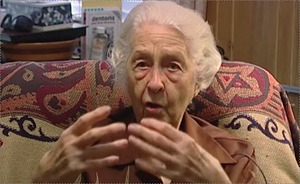 Here’s
a video about Elsie,
A Crusader for Conservation,
19 September 2014,
by Tennessee’s Wild Side, “The Emmy Award winning show produced through the generosity of the Jackson
Foundation, Tennessee State Parks, and the Tennessee Wildlife Federation.”
Lots of good pictures, some video snippets of Elsie, and some narration by her nephew Patrick and by Biologist Tom Hemmerly, who reminds us of Elsie’s work at Radner Lake, in addition to her cedar glades work.
Ranger Buddy Ingram explains her biggest contribution may have been
in getting numerous different segments of society to cooperate
in saving whole ecologies.
Botanist Kim Sadler and others explain how inspiring all that is to generations
of students.
Here’s
a video about Elsie,
A Crusader for Conservation,
19 September 2014,
by Tennessee’s Wild Side, “The Emmy Award winning show produced through the generosity of the Jackson
Foundation, Tennessee State Parks, and the Tennessee Wildlife Federation.”
Lots of good pictures, some video snippets of Elsie, and some narration by her nephew Patrick and by Biologist Tom Hemmerly, who reminds us of Elsie’s work at Radner Lake, in addition to her cedar glades work.
Ranger Buddy Ingram explains her biggest contribution may have been
in getting numerous different segments of society to cooperate
in saving whole ecologies.
Botanist Kim Sadler and others explain how inspiring all that is to generations
of students.
As Elsie said in 2006:
The general public needs to know what’s around them. They need to be learning that there’s a world that is not paved. There are lots of things that have life and function in the whole scheme, people as well as plants and animals. Not just dogs you’ve got on a leash, but animals that live out there, are part of the whole ecosystem.
If you’re fortunate you might meet one person in life whose personality and accomplishments almost defy description. It could be a celebrity, an officeholder or in the case of Elsie Quarterman, a botanist. When she passed away at the age of 103, Elsie had accomplished what so many people wish for themselves: professional recognition, pioneering work and the undying love and respect of her students. She was the protector of cedar glades, the savior of the Tennessee purple coneflower, a mentor to many and a relentless advocate for the preservation of special places. Wild Side Guide Alan Griggs shows us how Elsie Quarterman and her lifelong work will benefit generations to come.
In 1971, Elsie’s efforts led Tennessee to become one of the first states to pass legislation protecting natural areas. Today, there are over 80 state natural areas for the public to enjoy. While her accomplishments are too numerous to list, Elsie leaves our natural world a better place—from the plants and animals she loved to the strange and beautiful habitat in which they live. Today her students carry on her work, but ALL of us benefit from her extraordinary dedication to the wild side of our state.
Every year, generally around the first weekend of May, the Cedars of Lebanon State Park hosts the Elsie Quarterman Cedar Glade Festival. A favorite event in middle Tennessee, this free festival is co-sponsored with the Center for Cedar Glade Studies Program at Middle Tennessee State University. As young and old enjoy the annual Cedar Glades Festival now held in her memory, they experience firsthand the world Elsie Quarterman always loved. Today’s cedar glades and the beautiful life they support are a testament to that lifetime of love, and we are all better for it.
Cedars of Lebanon State Park is located in Wilson County and is part of the Cedars of Lebanon State Forest. The park is named for Eastern Red Cedar trees found throughout the area. The trees reminded early American settlers of the famed Biblical cedar forests that thrived across Mount Lebanon in what is now the Mediterranean area. In the 1940s, botanists noticed unique natural ecosystems found in and around Cedars of Lebanon State Park and Forest. These areas are natural rock gardens called cedar glades. The presence of glades is due to limestone rock coming so close to the surface of the ground that it causes the soil to be thin or absent. The small amount of soil that does exist along the cracks and potholes in the limestone slab, has been built up over many years. Water and surface temperatures vary so much throughout the year that a harsh, desert-like, inhospitable habitat is created with its own unique plant community. Nineteen rare and endangered species of plants grow profusely here and nowhere else in the world.
From show 2804
-jsq
Short Link: